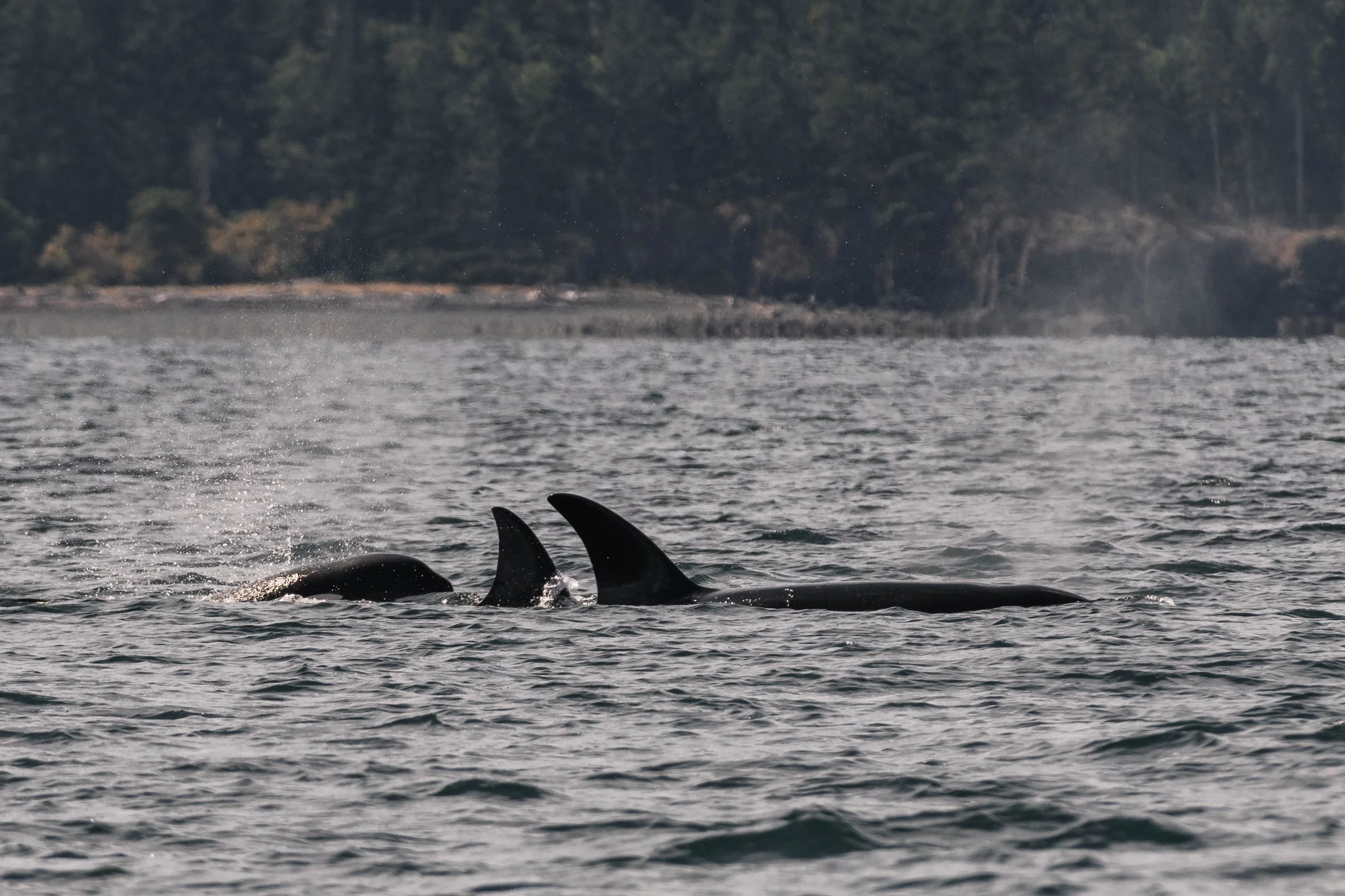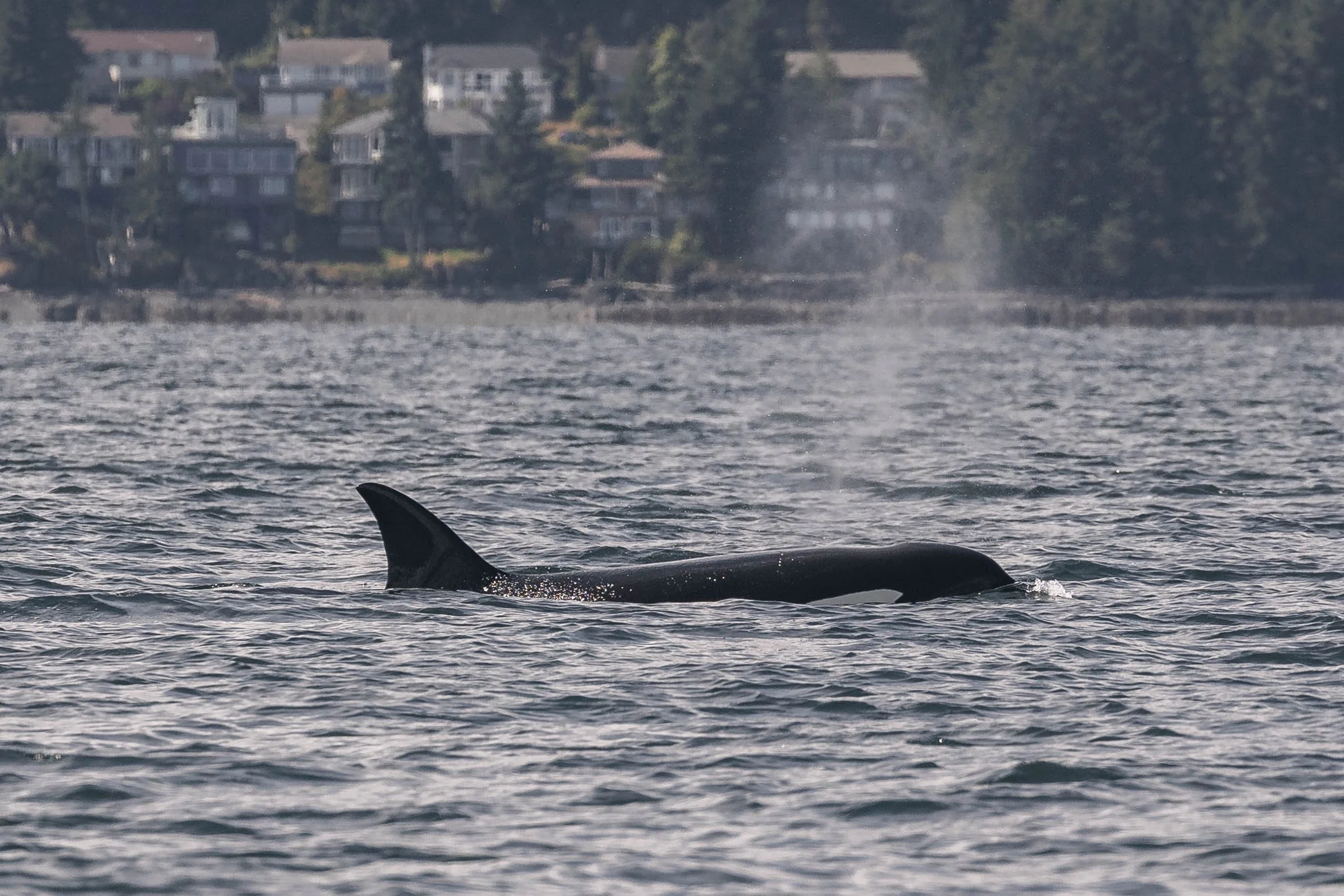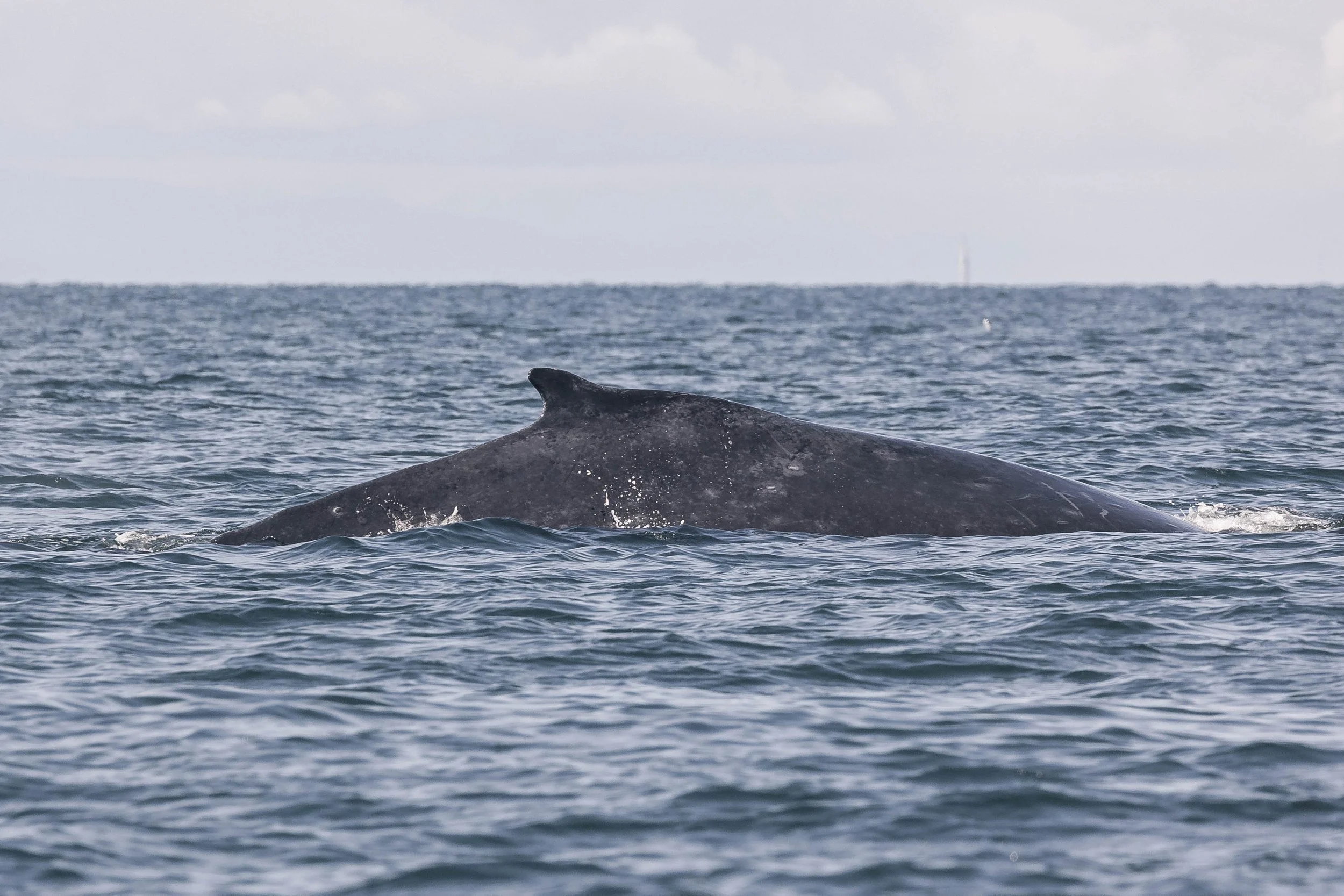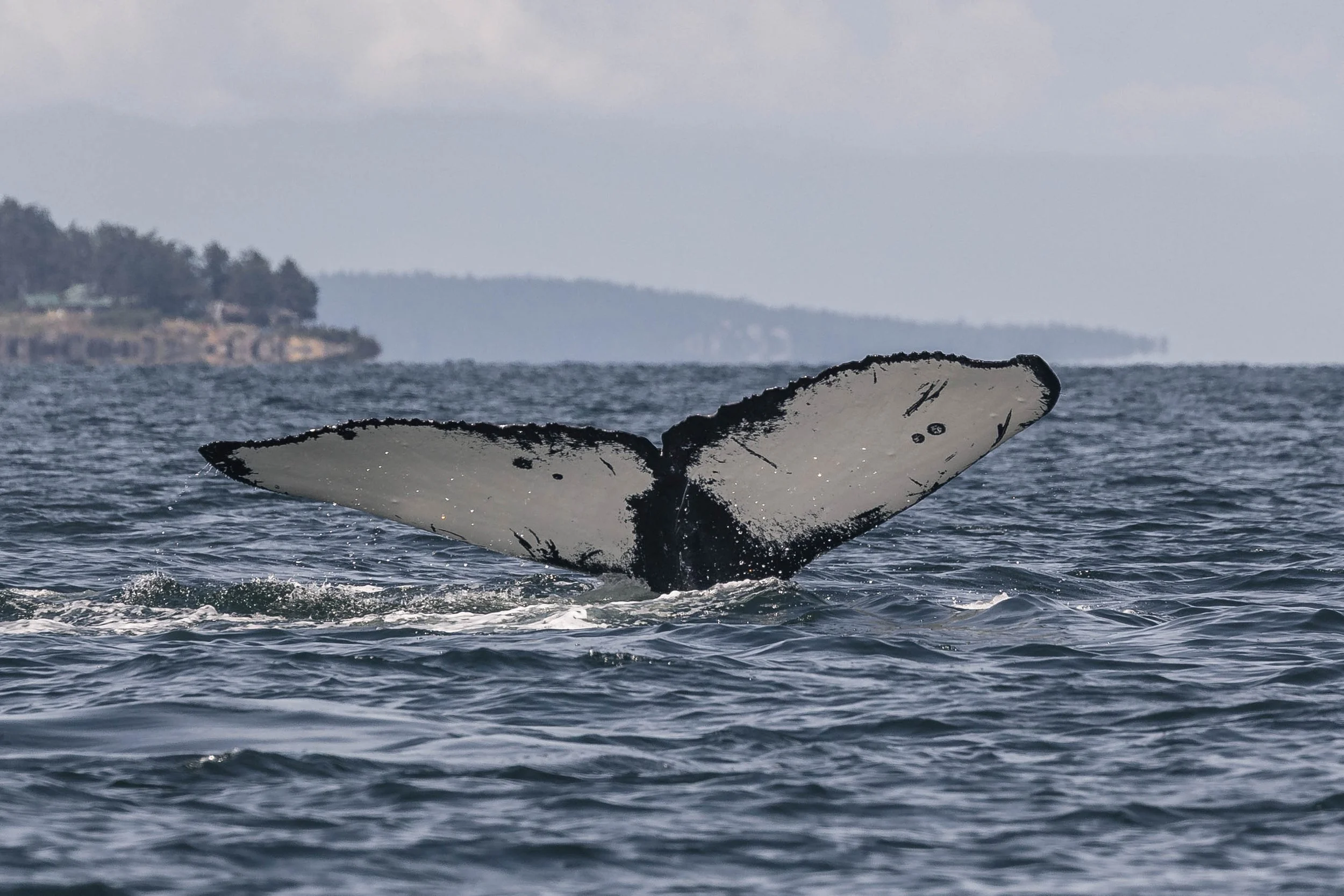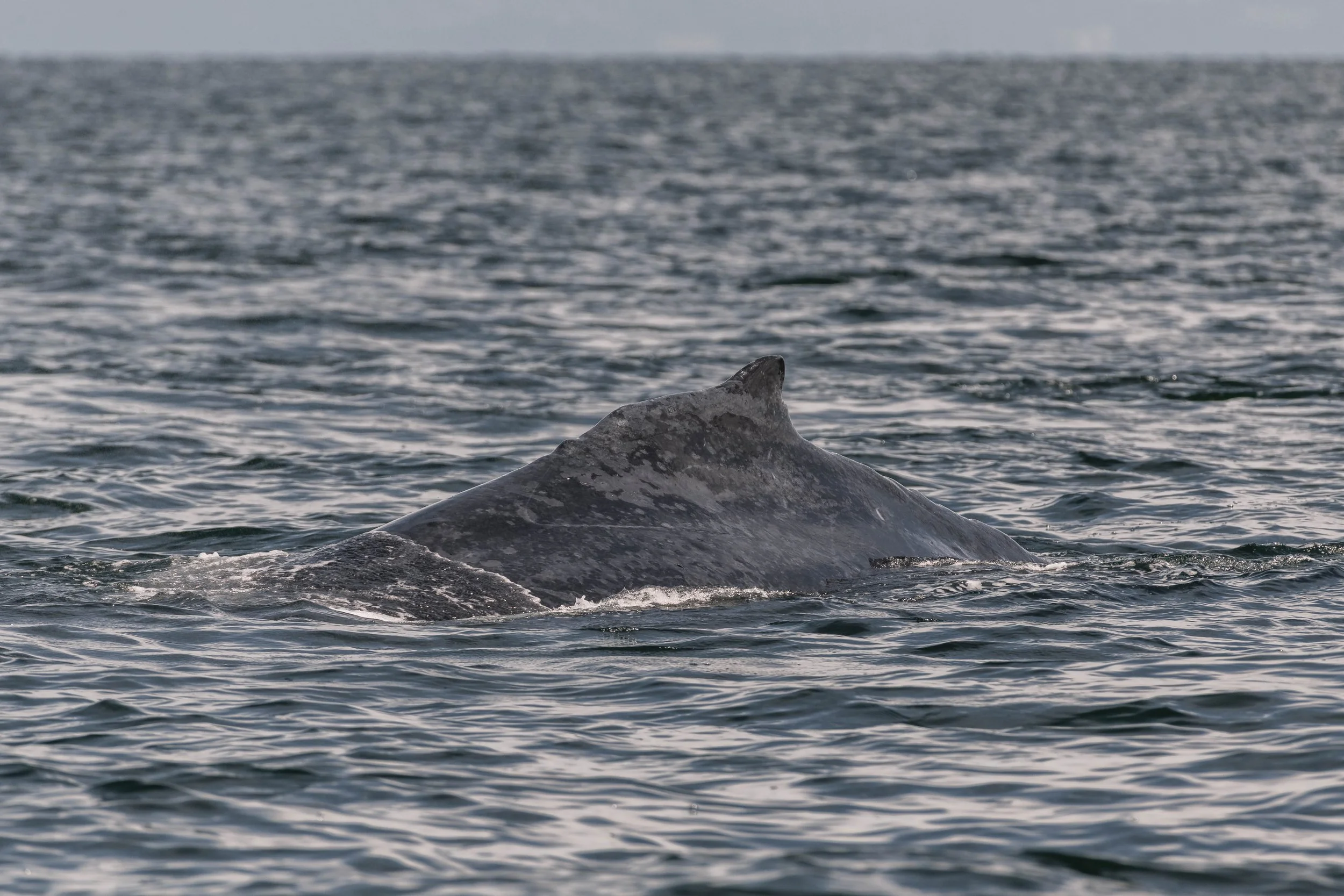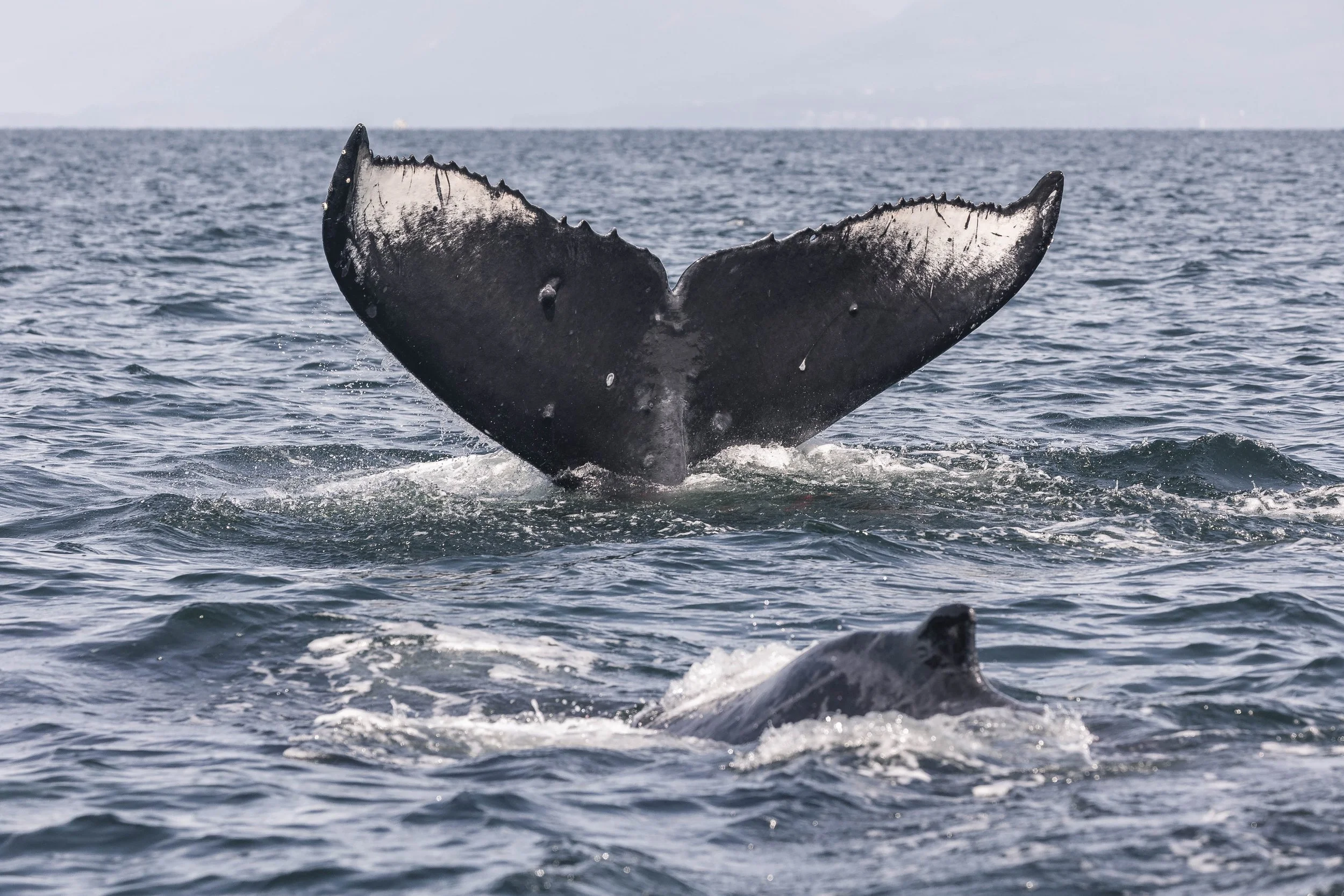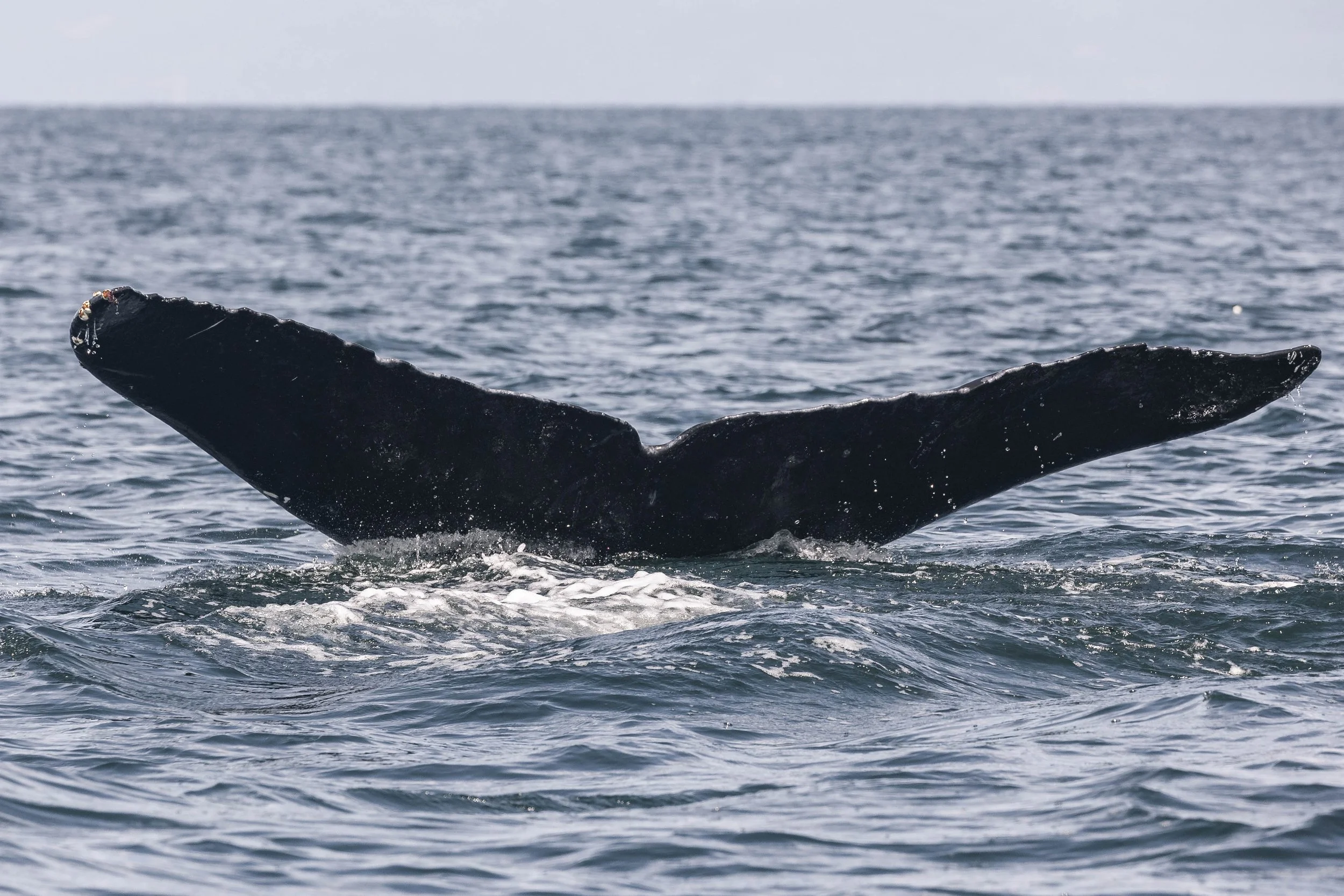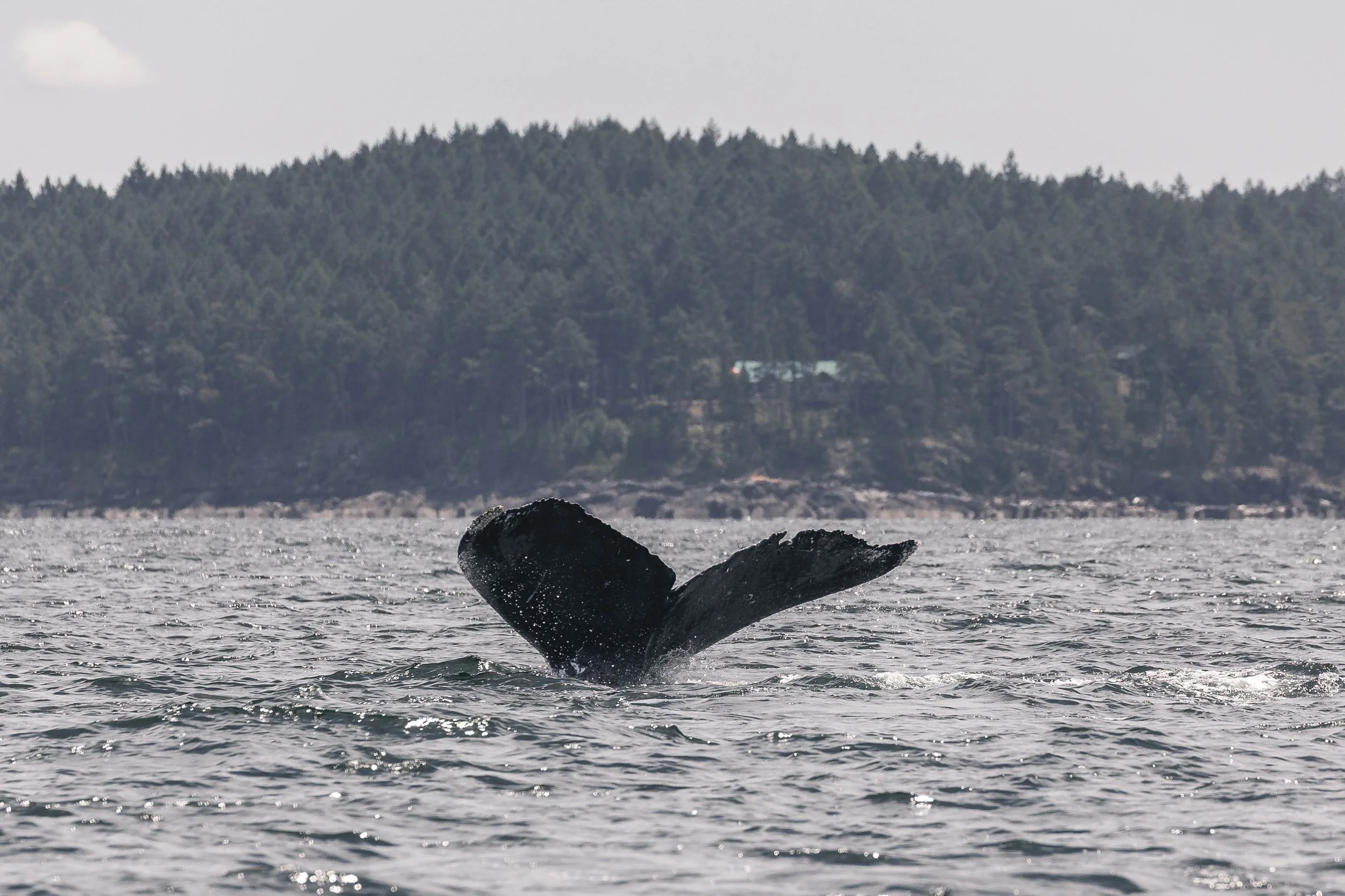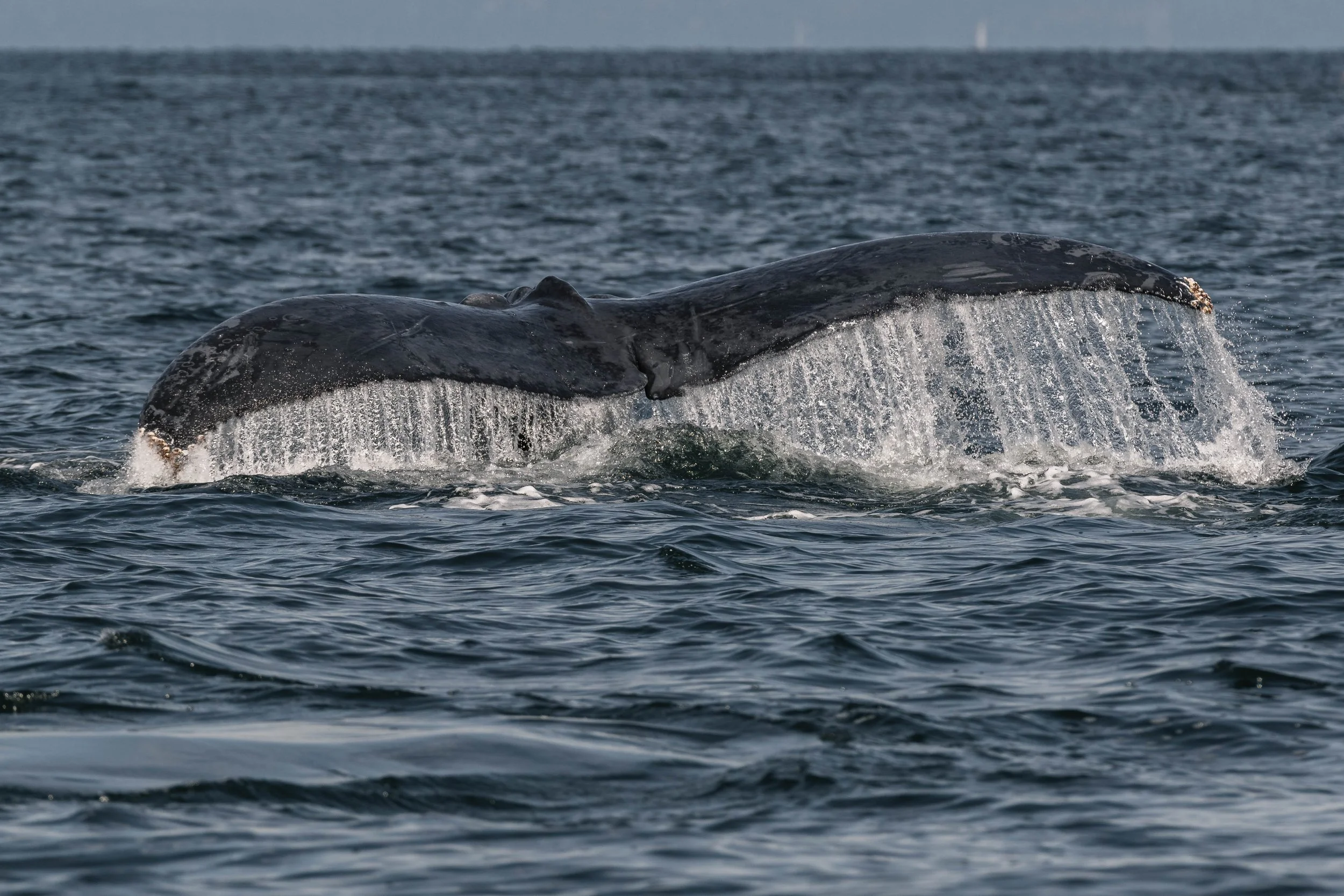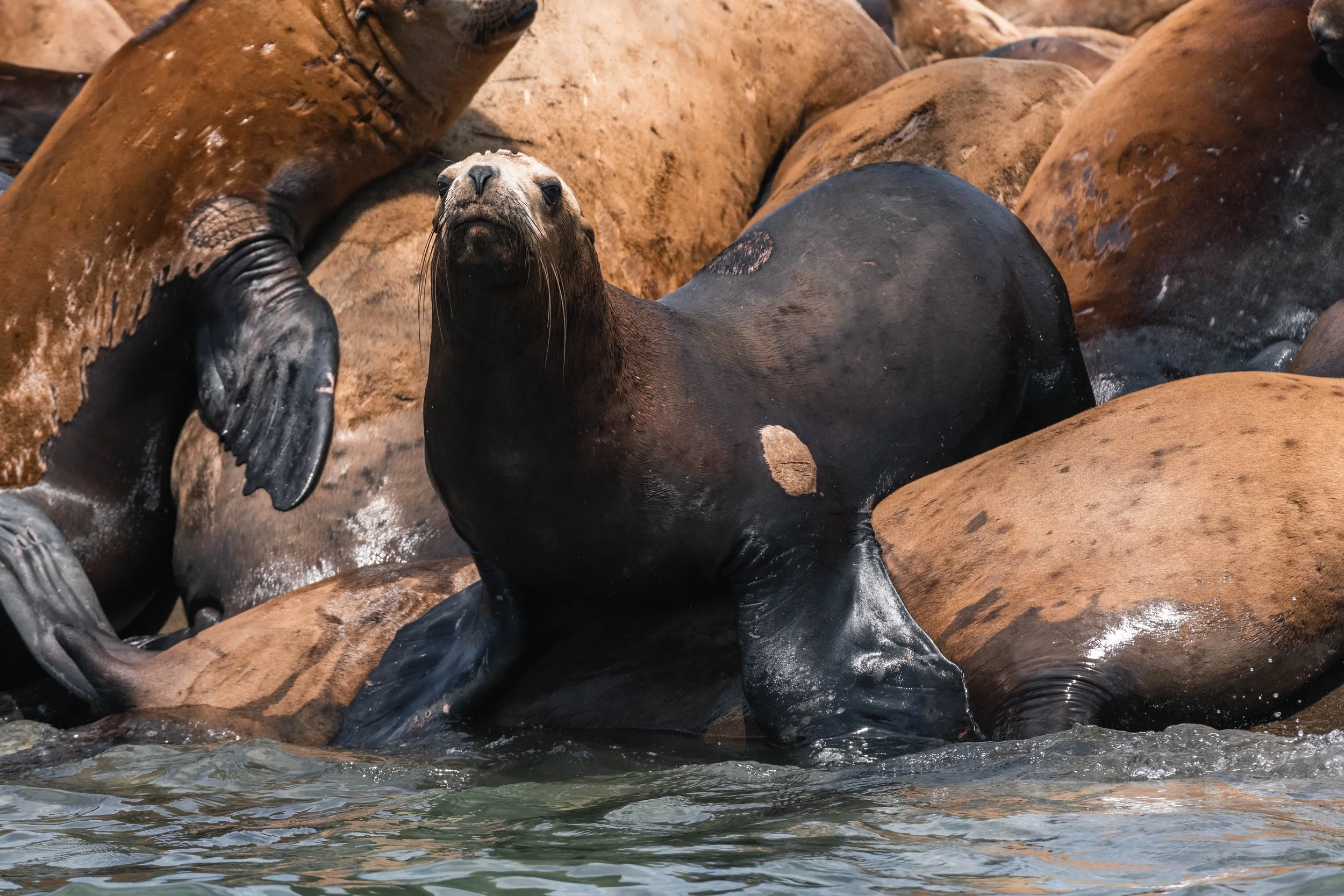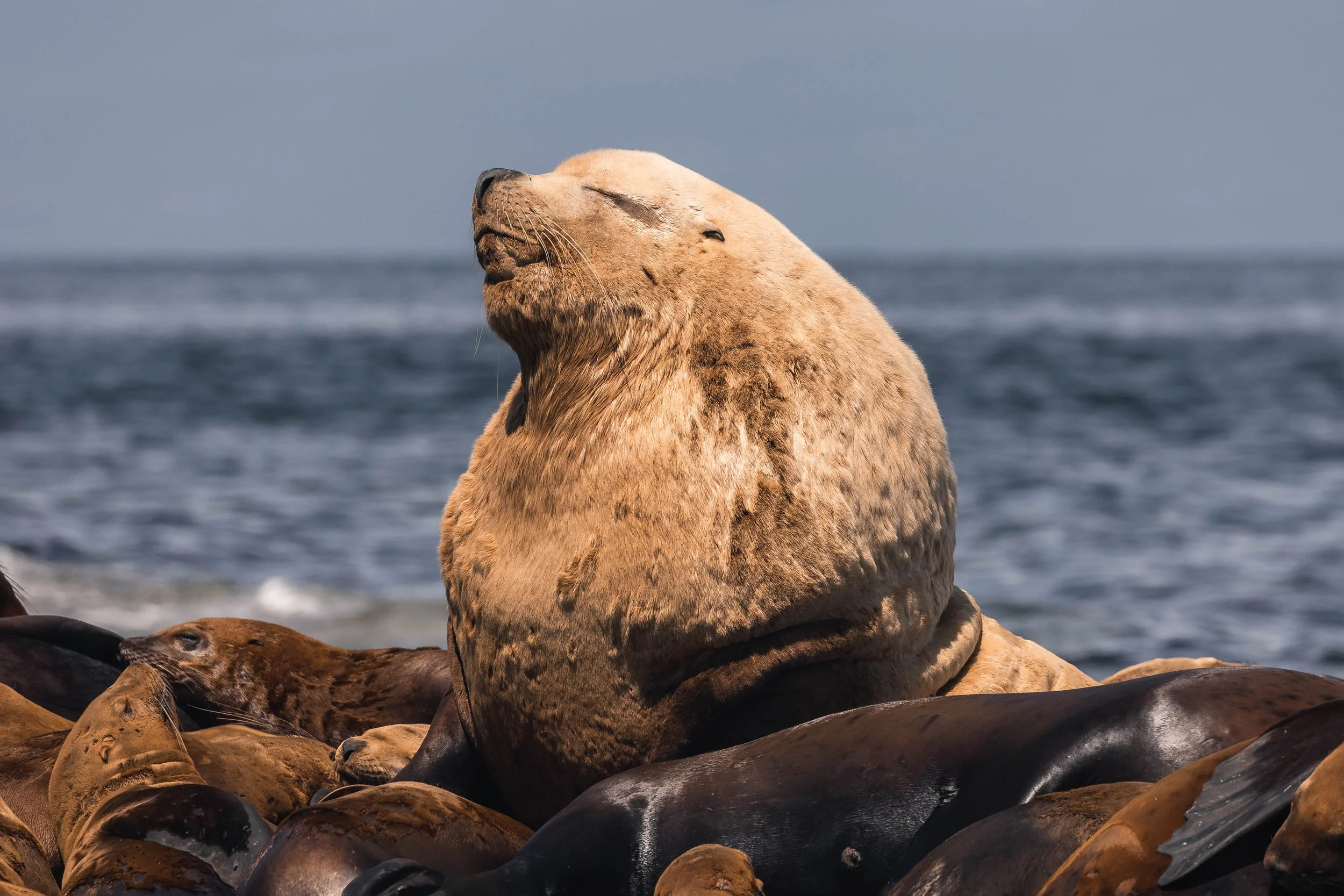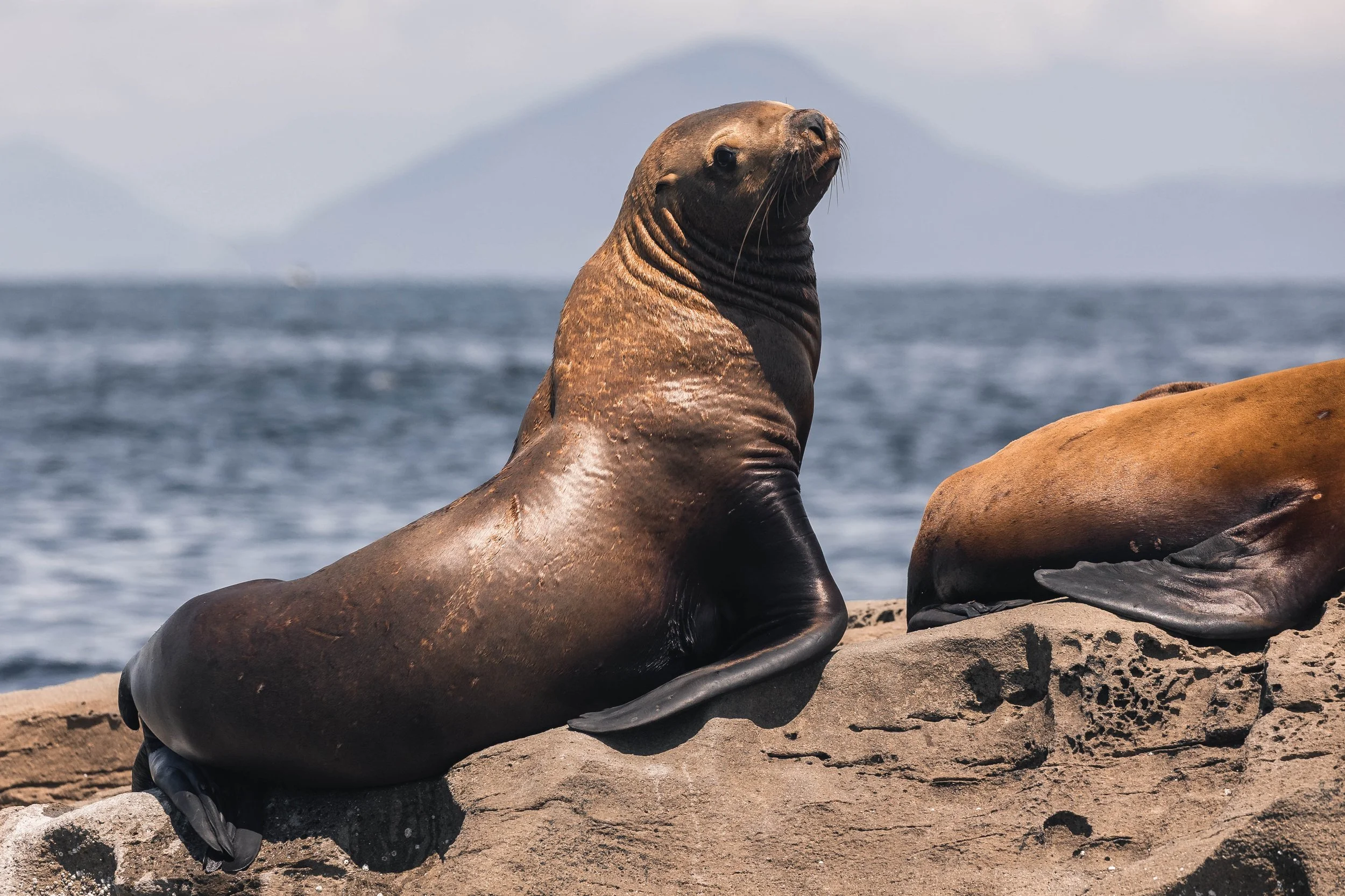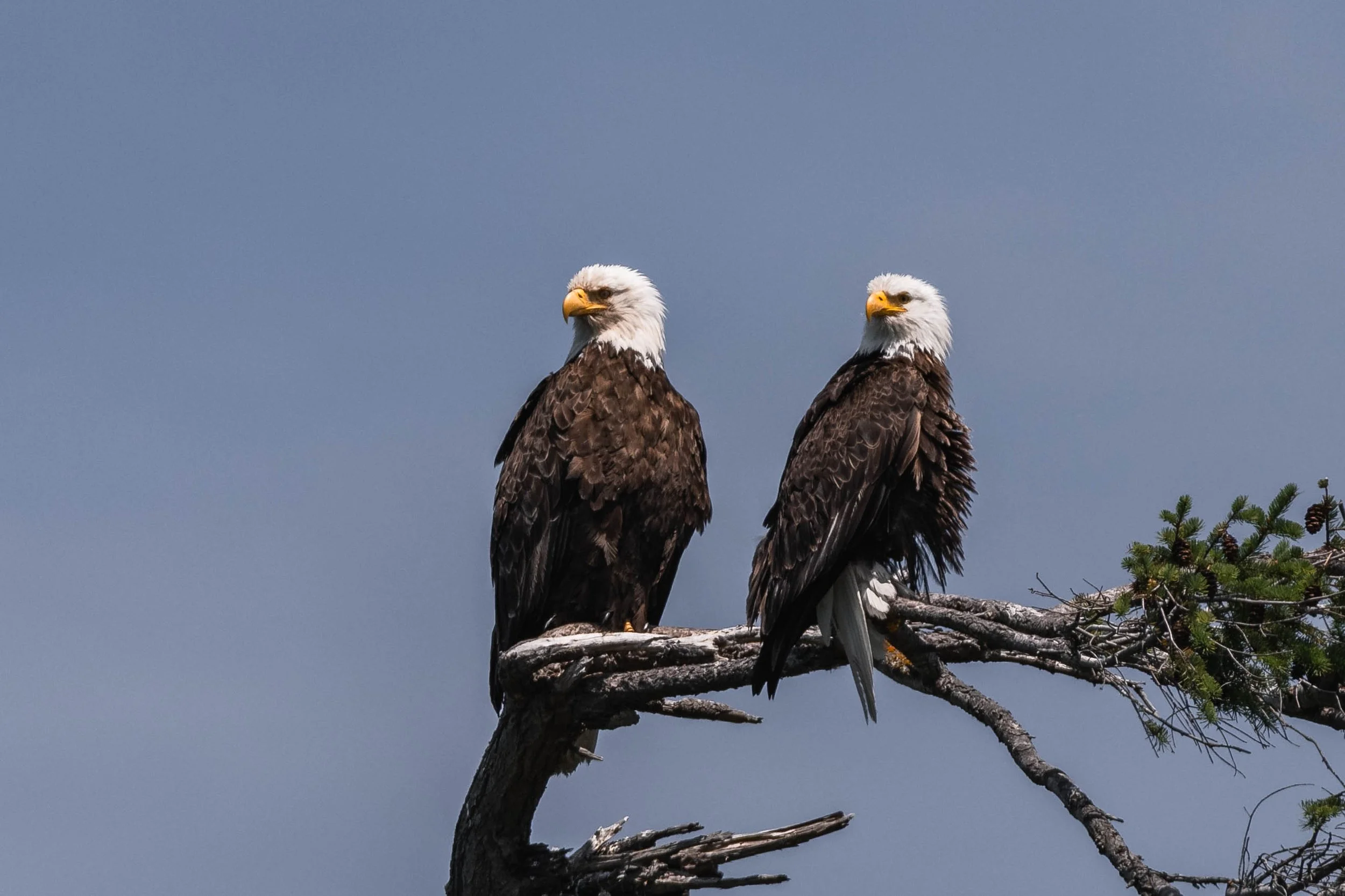July 3, 2025, 10:30 AM - The T069s and T036As close to home, and a humpback party.
The full fleet pushed off the dock and headed north into the Strait of Georgia, we did not have to travell far today before we spotted the orca that were seen from shore earlier. They were close to shore when we found them, most likely patrolling for a meal. The orca present today were:
T036A Leland ♀ (1990)
T036A2 Kailas ♀ (2012)
T036A3 Storm/Mike III ♂ (2015)
T036A5 Squall ♂ (2021)
T069 Komox ♀ (~1974)
T069C Kye ♂ (1995)
T069E Kodiak ♂ (2004)
T069F Kin ♂ (2010)
Orca need to consume approximately 300 pounds of food each day and may travel over 100 kilometres in search of prey. Our local transient (or Bigg’s) orca are marine mammal specialists, with harbour seals making up the majority of their diet. This is due not only to the seals' abundance in these waters but also because they are generally easier to hunt compared to other prey. Orca often patrol rocky shorelines and kelp forests where seals haul out to rest, using their exceptional hearing to detect the smallest splash or movement.
What makes these hunts so impressive is how silently the orca move during these moments. Unlike other times when they may be vocal, transient orca typically remain quiet while hunting to avoid alerting their prey. They approach slowly and stealthily underwater, sometimes from directly beneath their target, before launching a sudden, explosive chase. Once the hunt begins, harbour seals may attempt to escape by darting into crevices, hiding in underwater caves, or diving into dense kelp beds, areas where the much larger orca may struggle to follow.
Despite the danger, harbour seals are not entirely defenceless. They are surprisingly agile and often use their intimate knowledge of the shoreline and tides to their advantage. In some remarkable cases, we've seen seals make last-second leaps onto rocky outcrops or even clamber onto floating debris or nearby boats to evade capture. Kelp forests, in particular, serve as an effective refuge, the long strands can interfere with the orca’s echolocation and physically obstruct their pursuit.
Sea lions are also frequent targets for orca, but they present a much greater challenge. When hunting Steller and California Sea Lions, orca face larger, stronger, and more aggressive prey. Adult male sea lions can weigh several hundred kilograms and are capable of putting up a serious fight. Orca often use coordinated attacks to isolate young or vulnerable individuals from the group. However, adult sea lions do not go down without a struggle—they twist, thrash, and bite with powerful jaws, and in some cases will even confront the orca head-on. Steller sea lions, in particular, have been observed diving into crashing waves or hauling out onto slick, rocky ledges where orca cannot follow. These encounters are intense and often violent, showcasing the strength and determination of both predator and prey.
Porpoises and dolphins are also on the menu in the Salish Sea, but these prey come with a different challenge: speed and agility. These smaller cetaceans are fast, agile, and capable of rapid directional changes, making them difficult to catch. Orca rely on endurance, strategy, and teamwork in these hunts, often working together to corral or exhaust their quarry. In some cases, they will use their own wakes to unbalance porpoises or dolphins. Still, escape is possible, prey may evade capture by diving deep, fleeing into complex terrain, or leaping unpredictably. Large dolphin pods sometimes band together to confuse and outmaneuver the orca, turning the encounter into a high-speed, ocean-wide chase.
On rare occasions, Bigg’s orca have even been documented hunting minke whales. These hunts are typically dramatic and prolonged. While minkes are the smallest of the baleen whales, averaging 30 to 35 feet in length, they are still powerful swimmers capable of reaching high speeds. Orca usually target young or solitary individuals, using sophisticated teamwork to isolate and wear them down. They may alternate in chasing, attempt to herd the whale into shallower waters, or flank it to disrupt its escape. However, minkes are agile for their size and may dive deep, change direction suddenly, or flee into coastal shallows to escape. These encounters can last for hours and do not always result in a kill, highlighting the difficulty orca face in bringing down even relatively small whales.
After spending time with our local orca pods, they eventually split off in different directions, and so did we. We continued our search through the Strait, this time heading south. Along the way, we found ourselves drawn to a spot affectionately known as “Stinky Rocks,” a well-known haul-out for seals and sea lions. I imagine they were quite pleased the orca had continued north!
Harbour seals and sea lions haul out on rocky outcrops, sandy beaches, and even floating docks, coming ashore to rest, regulate their body temperature, socialize, and in some cases, give birth and nurse their young. These areas are vital for their survival, offering a place to recover between foraging trips and warm up after long, cold dives. Steller and California Sea Lions often haul out in large, noisy groups, using vocalizations to establish dominance and maintain social bonds. In contrast, harbour seals are more solitary and quiet, even when resting close together. While haul-outs are essential for their health and life cycles, they also make these animals more visible, and sometimes more vulnerable, to nearby orca.
After watching sea lions bicker over prime sunning spots, we resumed our search. It wasn’t long before we noticed tall blows in the distance along Gabriola Island’s shoreline. As we approached, we counted six individuals. It was indeed a humpback party! We had Yakima (BCX2182), Camelot (BCY1458), Two Spot (BCZ0432), Anvil (BCZ0410), Ocular (BCX1705), and Hitchiker (BCX2020).
Humpback whales frequently gather in highly productive areas where ocean currents, tidal flow, and underwater features such as narrows or banks cause nutrient-rich waters to upwell. This process supports dense schools of small fish and krill, drawing in feeding whales. In the Salish Sea, areas like Dodd Narrows and Boundary Pass serve as key feeding grounds where multiple humpbacks may be seen working the same patch of water. Humpbacks are filter feeders, using massive baleen plates to strain enormous mouthfuls of prey-laden water, often lunging upward through tightly packed bait balls of herring, anchovy, or other schooling fish. These feeding grounds are dynamic ecosystems, and the presence of humpbacks is often a strong indicator of a healthy, thriving marine environment. Based on their activity, it looked like we had stumbled upon a full humpback buffet, each whale needs to consume between 3,000 and 5,000 pounds of food per day! After watching our friendly giants feed, it was time to make our way back to the dock.
Photos by Aly Kohlman, Hayleigh Hilbert and Vanessa Vereschahen.
T069F Kin followed by T069E Kodiak. Photo by Vanessa Vereschahen.
T036A Storm/Mike. Photo by Aly Kohlman.
T036A Storm/Mike in the lead, T036A Leland with T036A5 in tow. Photo by Aly Kohlman.
T036A Leland with T036A5 following. Photo by Aly Kohlman.
T069C Kye. Photo by Aly Kohlman.
T069C Kye, such a big whale, such a small eye patch! Photo by Aly Kohlman.
T069C Kye. Photo by Aly Kohlman.
T069 Komox with T069F Kin following. Photo by Aly Kohlman.
T036A Leland. Photo by Hayleigh Hilbert.
T069F Kin followed by T036A3 Storm. Photo by Hayleigh Hilbert.
All together. Photo by Hayleigh Hilbert.
Thar she blows! Photo by Hayleigh Hilbert.
Anvil’s dorsal. Photo by Hayleigh Hilbert.
Anvil fluking. Photo by Hayleigh Hilbert.
Two Spot fluking. Photo by Hayleigh Hilbert.
Ocular’s dorsal. Photo by Aly Kohlman.
Two Spot in front Ocular surfacing behind. Photo by Hayleigh Hilbert.
Hitchhiker’s dorsal fin. Photo by Vanessa Vereschahen.
Hitchhiker in front of Entrance Island. Photo by Vanessa Vereschahen.
Yakima with a tail flick. Photo by Aly Kohlman.
Camelot fluking. Photo by Hayleigh Hilbert.
Ocular fluking. Photo by Aly Kohlman.
Fluke waterfall. Photo by Hayleigh Hilbert.
Yakima fluking. Photo by Hayleigh Hilbert.
Ocular surfacing. Photo by Vanessa Vereschahen.
Anvil followed by Two Spot and Ocular in the rear. Photo by Hayleigh Hilbert.
Ocular. Photo by Hayleigh Hilbert.
Ocular diving. Photo by Aly Kohlman.
Steller Sea Lions on the rocks. Photo by Vanessa Vereschahen.
A Steller watching us back. Photo by Aly Kohlman.
A large male Steller. Photo by Hayleigh Hilbert.
Strike a pose. Photo by Hayleigh Hilbert.
Harbour seals sunning. Photo by Hayleigh Hilbert.
Adorable harbour seals. Photo by Hayleigh Hilbert.
A couple of Bald Eagles perched. Photo by Aly Kohlman.



